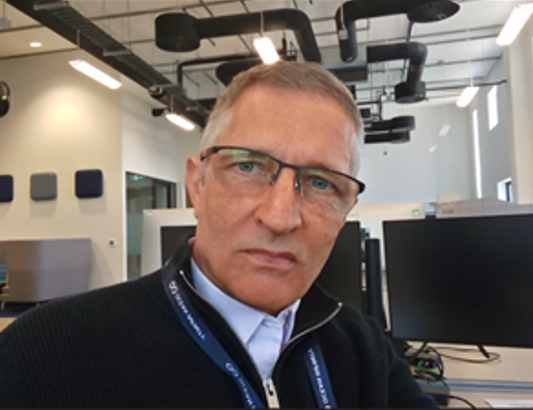For those of you who want me to participate in funded research projects, please see the 1-page summary bio below:
Bio – Rocco Van Schalkwyk (Xzistor LAB, UK)
Rocco Van Schalkwyk (B.Eng[Mech], M.Eng[Mech]) is a mechanical engineer with a career spanning over 30 years in the naval/marine, aerospace/defence, nuclear and robotics industries. Currently the Safety Engineering Lead at Ocean Infinity Ltd, his remit includes safety across the company’s robotic ship and autonomous underwater vehicle engineering programmes.
Rocco has a personal interest in humanoid robotics and in 1993 started developing a functional brain model from first principles. The Xzistor Concept Mathematical Model of Mind (‘Xzistor brain model’) was provisionally patented in 2002 (South Africa) and supported by a simulation of a single agent in a learning confine, demonstrating the model’s ability to provide a ‘learning agent’ with artificial emotions and cognition. Although a very basic simulation (C++ and OpenGL), it proved the functional model under dynamic conditions and showed that there were no exceptions to the model’s generality.
After presenting his paper “Emotion Modelling for Robots” at the IEEE Africon Conference in 2007, Rocco was invited to demonstrate the Xzistor brain model at the Frankfurt University of Applied Sciences where he illustrated how the simulation can quickly be altered to represent a Fraunhofer Volksbot robotic platform (and its sensors) driven by an Xzistor ‘artificial brain’.
In 2011 Rocco designed and built a physical robot resembling the simulated agent in a ‘learning confine’. The robot was deliberately kept simple – Java program (PC-based) to Java Virtual Machine (robot-based) with HD video (slipring umbilical), WiFi and Bluetooth connection. This proved that the simulation could be ported to hardware robots.
After making videos of numerous ‘test cases’ using the physical robot, Rocco started making information available on the Xzistor brain model in the public domain. He also published two short books on Amazon ‘Understanding Intelligence’ and ‘Understanding Emotions’ based on this functional ‘substrate-independent’ model. A neuroscientist, Dr. Denise Cook (PhD), working on similar approaches in Canada, did an in-depth study of the model and started collaborating with Rocco on ‘locating’ the areas in the biological brain providing the functional mechanisms proposed by the Xzistor brain model. She also started a YouTube Channel discussing insights from the model called ‘Conversations on the Mind’.
In 2022 Rocco published a preprint ‘The Xzistor Concept: a functional brain model to solve Artificial General Intelligence’ to bring attention to the potential of this model not just as way to understand the brain, but also as way to provide a unified platform to bring together related brain research into a high-level functional brain model that can be used to provide agents with emotions and cognition.
Rocco and his team of independent researchers at the Xzistor LAB are now building a new agent (robot/simulation combo) referred to as a ‘Language Learning Infant Agent’.
His new paper, ‘Artificial Agent Language Development based on the Xzistor Mathematical Model of Mind‘ (1 Jul 2024) written with neurolinguist Alireza Dehbosorgi, provides a theoretical basis for how Xzistor agents can develop a language learning capability using artificial emotions as defined by the Xzistor Mathematical Model of Mind. A multi-stage project is proposed to demonstrate how an Xzistor agent will develop a language skill like and infant and then refine this skill towards improved syntax and grammar use with further reinforcement learning. The paper provides two appendices covering the mathematical principles of the Xzistor brain model and an explanation of how it could potentially unify behaviorist and structuralist language theories.
Find the new paper (preprint on ResearchGate) here:
Artificial Agent Language Development based on the Xzistor Mathematical Model of Mind
Quick Links:
I am always happy to get together with those interested in the Xzistor brain model – the old, the young, and the curious – for a chat over coffee, a more formal discussion, or for doing presentations/ talks/ interviews, etc. Also just happy to answer ANY questions on my brain model or robots!
Reach out!
Some links below to my Xzistor robotics and brain modeling projects:
Email: xzistor@live.com
Rocco Bio (this page): https://www.xzistor.com/summary-bio-rocco-van-schalkwyk/
Website: https://www.xzistor.com/xzistor-concept-frequently-asked-questions/
Papers on ResearchGate: https://www.researchgate.net/profile/Rocco-Van-Schalkwyk
Books: https://www.amazon.co.uk/dp/B096QSNKQ9, https://www.amazon.co.uk/dp/B091JPBLH1

[Free digital copies of the above books available on request.]
YouTube Interviews: https://www.youtube.com/@personalitygenie
Robot Videos: https://www.youtube.com/@xzistor
Blog: https://www.xzistor.com/blog/
X (Twitter): https://x.com/xzistor
LinkedIn: https://www.linkedin.com/in/brainwave/
